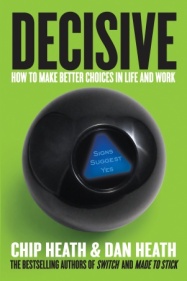- Categories:
Wi9 Plenary Speaker Dan Heath on Boosting Our Chances of Success by Preparing to Be Wrong [5]
- By Dan Cullen [6]
 The opening plenary speaker for Winter Institute 2014 [7] will be bestselling author Dan Heath, who will talk about why so many critical business decisions are flawed, and — more importantly — how booksellers can do better.
The opening plenary speaker for Winter Institute 2014 [7] will be bestselling author Dan Heath, who will talk about why so many critical business decisions are flawed, and — more importantly — how booksellers can do better.
Here’s the fourth in a series of key insights and tips from Decisive, in anticipation of a plenary talk that will do much to answer the question of how we can make better choices in life and work.
Dan Heath and his brother, Chip, are the co-authors of the bestselling business book Decisive (Crown Business), which explores key aspects of the decision-making process and offers insightful strategies and practical tools to help individuals and businesses make better decisions.
 A key concept regarding decision-making in Chip and Dan Heath’s Decisive is what they term the WRAP process. As they point out, to make better choices, we must avoid the most common decision-making biases. Simple awareness often is not sufficient to avoiding them, but a process can help. The WRAP process is a big asset in making better, bolder decisions.
A key concept regarding decision-making in Chip and Dan Heath’s Decisive is what they term the WRAP process. As they point out, to make better choices, we must avoid the most common decision-making biases. Simple awareness often is not sufficient to avoiding them, but a process can help. The WRAP process is a big asset in making better, bolder decisions.
The Wrap Framework
- Widen Your Options [8]
- Reality-Test Your Assumptions [9]
- Attain Some Distance Before Deciding [10]
- Prepare to Be Wrong
Step 4: Prepare to Be Wrong
A wealth of research confirms that people tend to be overconfident, meaning that they think they know more than they do about how the future will unfold. To boost our chances of success, we need to be humble enough to prepare to be wrong. We should anticipate and plan for bad outcomes as well as good ones. And we should also think through what would make us reconsider our decisions.
The most important tools to keep in mind:
Run a premortem — The psychologist Gary Klein created a tool called the premortem that you can use with your team. Let’s assume you’ve just made a major decision. Ask your team to consider the following: It’s a year from now and the decision was a disaster. A total fiasco. People have been fired as a result. The question is: Why did it fail? Let everyone brainstorm individually, and then allow everyone to share all of their answers before you discuss them. In the discussion, try to combine your insights and prepare a list of the top two to three threats that are most probable and most serious. How can you forestall or minimize these threats? (Despite the bleak premise of the premortem, you’ll be surprised how fun it can be.)
Use a safety factor — A classic kind of overconfidence is called the “planning fallacy,” which means that people usually underestimate (sometimes dramatically) how long it will take to accomplish something. (Think of operating system releases or home-improvement contractors.) As a leader, you can’t afford to trust these estimates at face value (even though your people mean them sincerely). So add what engineers call a “safety factor” — a buffer that reduces the cost if your projections prove wrong. Can you build in some extra slack in the schedule? Can you keep some powder dry in the budget in case things go wrong?
Set a tripwire — We treat our decisions as permanent, but usually they are provisional. They are simply our best predictions of what should be done, given what we know today. But shouldn’t we also consider what would make us reconsider a decision six months or a year down the line? We can set a “tripwire” to trigger such a reconsideration. For instance, if you approved an overhaul of your merchandising approach, you might set a tripwire: If sales dip by five percent next month, then we will get back together to reconsider it. Tripwires can also be useful to help us deal with slow-moving changes. Imagine that foot traffic near your location began a slow, steady decline. There would never be a “red alarm” moment. But if you set a tripwire — say, to address the issue if foot traffic ever drops below 90 percent of current levels — then you’d be armed to make a decision.
The Opening Plenary Breakfast With Dan Heath will be held from 8:30 a.m. to 10:00 a.m. on Wednesday, January 22, in the Westin Seattle’s Grand Ballroom.